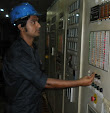Ladder Logic Inputs and outputs
Ladder Logic Inputs
PLC inputs are easily represented in
ladder logic. In Figure below, there are three types of inputs shown. The first
two are normally open and normally closed inputs, discussed previously. The IIT
(Immediate InpuT) function allows inputs to be read after the input scan,
while the ladder logic is being scanned. This allows ladder logic to examine input
values more often than once every cycle.
Normally open, an active input x will
close the contact and allow power to flow.
Normally closed, power flows when the
input x is not open.
Immediate inputs will take current
values, not those from the previous input scan. (Note: this instruction is
actually an output that will update the input table with the current input
values. Other input contacts can now be used to examine the new values.)
Ladder Logic Outputs
In ladder logic there are multiple
types of outputs, but these are not consistently available on all PLCs. Some of
the outputs will be externally connected to devices outside the PLC, but it is
also possible to use internal memory locations in the PLC. Six types of outputs
are shown in Figure below. The first is a normal output, when energized the
output will turn on, and energize an output. The circle with a diagonal line
through is a normally on output. When energized the output will turn off. This
type of output is not available on all PLC types. When initially energized the OSR
(One Shot Relay) instruction will turn on for one scan, but then be off for
all scans after, until it is turned off. The L (latch) and U (unlatch)
instructions can be used to lock outputs on. When an L output is
energized the output will turn on indefinitely, even when the output coil is
deenergized. The output can only be turned off using a U output. The
last instruction is the IOT (Immediate OutpuT) that will allow outputs
to be updated without having to wait for the ladder logic scan to be completed.
When power is applied (on) the output
x is activated for the left output, but turned off for the output on the right.
An input transition on will cause the
output x to go on for one scan (this is
also known as a one shot relay)
When the L coil is energized, x will
be toggled on, it will stay on until the U coil is energized. This is like a
flip-flop and stays set even when the PLC is turned off.
Some PLCs will allow immediate outputs
that do not wait for the program scan to end before setting an output. (Note:
This instruction will only update the outputs using the output table, other
instruction must change the individual outputs.)
NOTE
|
|
Outputs
are also commonly shown using parentheses -( )- instead of the circle.
This is because many of the programming systems are text based and circles
cannot be drawn.
|
|
















No comments